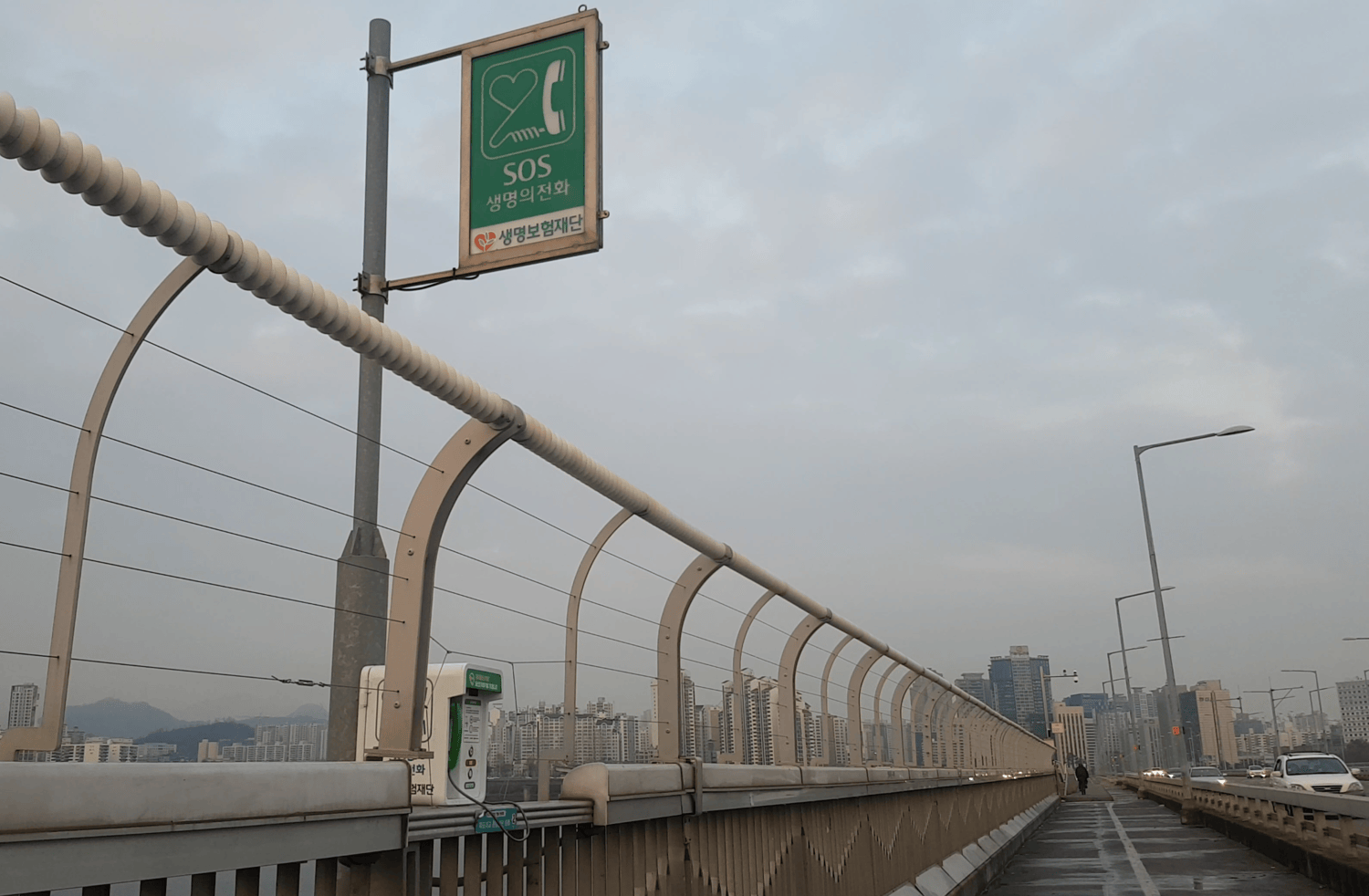Mapo Bridge: The Han River’s Bridge of Life
The Han River flows through the heart of Seoul, connecting its vibrant districts with stunning views and iconic bridges. Among the 27 bridges spanning the river, Mapo Bridge holds a tragic yet transformative reputation. Known globally as “The Suicide Bridge,” Mapo has witnessed despair but also become a symbol of hope due to proactive measures aimed at preventing suicides.

The History of Mapo Bridge
Mapo Bridge was completed in 1970 as the Seoul Bridge, designed to ease traffic flow between Mapo-gu and Yeouido. It became a lifeline for commuters and a vital part of the city’s infrastructure. In 1984, it was renamed to reflect its geographical location.
While other Han River bridges are celebrated for their architectural beauty or cultural significance, Mapo Bridge gained a somber reputation in the 2000s when it became one of the most frequented locations for suicides in Seoul. Its central location and easy accessibility made it a preferred site for people overwhelmed by life’s burdens.

A Nationwide Problem: Suicide in South Korea
South Korea has struggled with one of the highest suicide rates in the world. According to the World Health Organization (WHO), in 2019, South Korea ranked 5th globally for suicide rates. Among OECD countries, it consistently ranks at the top, with approximately 37 people taking their lives every day. Suicide is the leading cause of death for South Koreans aged 10 to 39.
Between 2015 and 2019, over 3,000 people attempted suicide by jumping off Han River bridges. Out of these, approximately 1,100 cases were from Mapo Bridge alone. Despite the staggering numbers, the 119 Rescue Team has managed to save 96.5% of the victims, a testament to their swift response and dedication.

Now the question is Why Do People Choose Suicide in Korea?
- Work Pressure and Burnout
South Korea is notorious for its grueling work culture, often referred to as “ppali ppali” (hurry, hurry). Many individuals feel trapped in an endless cycle of stress, long hours, and unrelenting expectations. - Economic Struggles
The pressure to achieve financial stability weighs heavily on individuals, especially young adults burdened by student loans or the elderly living in poverty. - Social Isolation
With an increasingly urbanized and individualistic society, feelings of loneliness and isolation have become widespread. - Mental Health Stigma
Despite the rising awareness of mental health issues, seeking therapy or psychiatric care remains taboo in South Korean culture. Many suffer in silence, afraid of being judged or ostracized.

Efforts Beyond Mapo Bridge
The South Korean government has taken several measures to address the suicide epidemic:
- Increased Surveillance
More CCTV cameras have been installed on all Han River bridges, allowing authorities to monitor and respond to emergencies quickly. - Anti-Suicide Barriers
Many bridges now have anti-climbing barriers and railings to deter attempts. - Mental Health Helplines
The government has expanded mental health services, including hotlines such as 1393 and 1577-0199, offering 24/7 support. - Public Awareness Campaigns
Nationwide initiatives like the Bridge of Life Campaign aim to reduce stigma around mental health and encourage people to seek help.
The Bridge of Life Campaign
In 2012, the Bridge of Life Campaign was launched on Mapo Bridge as a collaborative effort between Samsung Life Insurance and the Seoul Metropolitan Government. The campaign aimed to humanize the bridge and provide moments of reflection for those in distress.
Key features included:
- Motivational Messages
Messages like “Your mom is waiting for you,” “Tomorrow’s sun will rise,” and “The best is yet to come” were placed along the railings. These simple yet powerful words were meant to divert the thoughts of those considering suicide, urging them to reconsider. - Interactive LED Lights
Sensors activated LED lights that illuminated the messages as people walked by, creating a comforting and visually engaging experience. - Emergency SOS Phones
Special phones were installed along the bridge, allowing immediate contact with mental health professionals or emergency services. - Statues and Visual Elements
Cheerful statues were added to evoke a sense of joy and connection, while vibrant colors and artwork softened the bridge’s otherwise cold, industrial appearance. - Physical Barriers
The height of the railings was increased by 1 meter, making it more challenging for impulsive actions to be carried out.
A Personal Perspective
Standing on Mapo Bridge, with the Han River flowing endlessly beneath, one can feel the weight of the lives lost and the hope that remains. It’s sobering to imagine the thoughts that bring someone here but also heartening to see the efforts made to save them.
If you or someone you know feels overwhelmed, remember that suicide is not a solution. Life is unpredictable, and pain is often temporary. It might seem unbearable today, but tomorrow holds possibilities you can’t yet see. You are more than your struggles, and help is available.
How to Get to Mapo Bridge
Mapo Bridge is easily accessible from central Seoul.
- By Subway: Take Line 5 to Mapo Station. Exit 1 is the closest to the bridge.
- By Bus: Blue buses like 601, 753, and 261 have stops near the bridge.
Nearby Attractions
- Yeouido Hangang Park: A serene riverside park with biking trails, picnic spots, and seasonal flower festivals.
- 63 Square: Home to an observation deck, aquarium, and art gallery, the 63 Square offers some of the best views of the city.
- Nodeul Island: A cultural oasis on the Han River, featuring live performances, cafes, and scenic walking paths.
- Ewha Womans University Street: A lively area perfect for shopping and sampling Korean street food.
Additional Tips
- Visit Mapo Bridge in the evening to experience the LED-lit messages.
- If you notice someone in distress, call 119 immediately or use the SOS phones on the bridge.
- Take time to explore the Han River parks and enjoy the beauty that Seoul offers.









